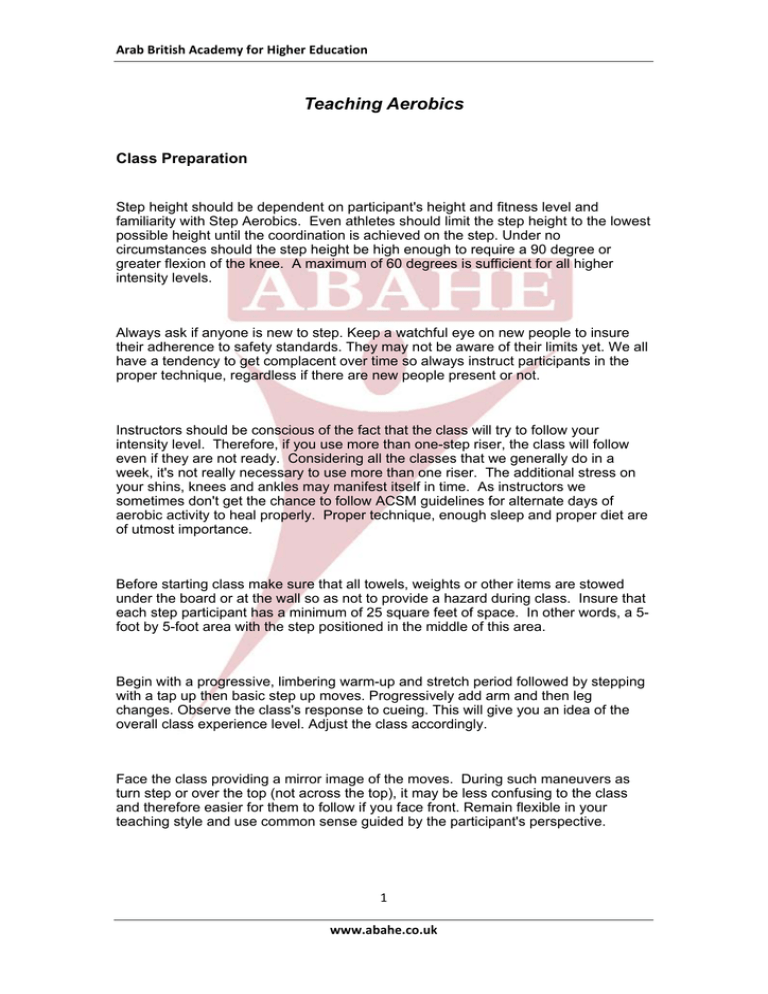
Arab British Academy for Higher Education Teaching Aerobics
Class Preparation
Step height should be dependent on participant's height and fitness level and
familiarity with Step Aerobics. Even athletes should limit the step height to the lowest
possible height until the coordination is achieved on the step. Under no
circumstances should the step height be high enough to require a 90 degree or
greater flexion of the knee. A maximum of 60 degrees is sufficient for all higher
intensity levels.
Always ask if anyone is new to step. Keep a watchful eye on new people to insure
their adherence to safety standards. They may not be aware of their limits yet. We all
have a tendency to get complacent over time so always instruct participants in the
proper technique, regardless if there are new people present or not.
Instructors should be conscious of the fact that the class will try to follow your
intensity level. Therefore, if you use more than one-step riser, the class will follow
even if they are not ready. Considering all the classes that we generally do in a
week, it's not really necessary to use more than one riser. The additional stress on
your shins, knees and ankles may manifest itself in time. As instructors we
sometimes don't get the chance to follow ACSM guidelines for alternate days of
aerobic activity to heal properly. Proper technique, enough sleep and proper diet are
of utmost importance.
Before starting class make sure that all towels, weights or other items are stowed
under the board or at the wall so as not to provide a hazard during class. Insure that
each step participant has a minimum of 25 square feet of space. In other words, a 5foot by 5-foot area with the step positioned in the middle of this area.
Begin with a progressive, limbering warm-up and stretch period followed by stepping
with a tap up then basic step up moves. Progressively add arm and then leg
changes. Observe the class's response to cueing. This will give you an idea of the
overall class experience level. Adjust the class accordingly.
Face the class providing a mirror image of the moves. During such maneuvers as
turn step or over the top (not across the top), it may be less confusing to the class
and therefore easier for them to follow if you face front. Remain flexible in your
teaching style and use common sense guided by the participant's perspective.
1 www.abahe.co.uk Arab British Academy for Higher Education Intensity and Complexity
There is a misconception of what constitutes beginner, intermediate and advanced
levels of aerobics. Generally, people equate class level with choreographic
complexity. It is physical exercise intensity level alone that determines class level and
subsequently heart rate. Complex moves, although fine for dance enthusiasts, can
be defeating and demoralizing to most of the people who are trying to learn complex
dance moves when they are really there to burn fat.
Intensity can be better served by utilizing large muscle groups quantitatively.
Complex dance moves can be icing on the cake after the intensity level has been
achieved by the aforementioned method. In many cases this may serve as a great
cool-down method since intensity and subsequently heart rate generally drops as the
participant slows down to learn new steps. Therefore, beginner, intermediate and
advanced level classes can be grouped further into two categories, complex and
non-complex denoting the choreographic complexity.
Leg muscles and arm movements will also add to intensity level. Intensity level can
be reduced by placing hands on the waist while continuing to step, by reducing the
height of the step or by reducing the tempo of the music. Step heights of 4 inches
provide intensity levels near those of walking briskly. A step height of 12 inches
exhibits near the same energy level as jogging at 5 to 7 mph.
All Rights Reserved © Arab British Academy for Higher Education 2 www.abahe.co.uk







